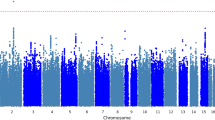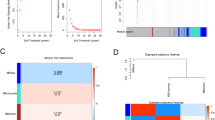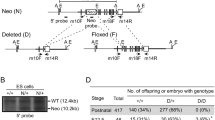Abstract
Muscle strength is important in functional activities of daily living and the prevention of common pathologies. We describe the two-staged fine mapping of a previously identified linkage peak for knee strength on chr12q12-14. First, 209 tagSNPs in/around 74 prioritized genes were genotyped in 500 Caucasian brothers from the Leuven Genes for Muscular Strength study (LGfMS). Combined linkage and family-based association analyses identified activin receptor 1B (ACVR1B) and inhibin β C (INHBC), part of the transforming growth factor β pathway regulating myostatin – a negative regulator of muscle mass – signaling, for follow-up. Second, 33 SNPs, selected in these genes based on their likelihood to functionally affect gene expression/function, were genotyped in an extended sample of 536 LGfMS siblings. Strong associations between ACVR1B genotypes and knee muscle strength (P-values up to 0.00002) were present. Of particular interest was the association with rs2854464, located in a putative miR-24-binding site, as miR-24 was implicated in the inhibition of skeletal muscle differentiation. Rs2854464 AA individuals were ∼2% stronger than G-allele carriers. The strength increasing effect of the A-allele was also observed in an independent replication sample (n=266) selected from the Baltimore Longitudinal Study of Aging and a Flemish Policy Research Centre Sport, Physical Activity and Health study. However, no genotype-related difference in ACVR1B mRNA expression in quadriceps muscle was observed. In conclusion, we applied a two-stage fine mapping approach, and are the first to identify and partially replicate genetic variants in the ACVR1B gene that account for genetic variation in human muscle strength.
Similar content being viewed by others
Log in or create a free account to read this content
Gain free access to this article, as well as selected content from this journal and more on nature.com
or
References
Rantanen T, Harris T, Leveille SG et al: Muscle strength and body mass index as long-term predictors of mortality in initially healthy men. J Gerontol A Biol Sci Med Sci 2000; 55: M168–M173.
Karasik D, Kiel DP : Genetics of the musculoskeletal system: a pleiotropic approach. J Bone Miner Res 2008; 23: 788–802.
Phan HM, Alpert JS, Fain M : Frailty, inflammation, and cardiovascular disease: evidence of a connection. Am J Geriatr Cardiol 2008; 17: 101–107.
Wijndaele K, Duvigneaud N, Matton L et al: Muscular strength, aerobic fitness, and metabolic syndrome risk in Flemish adults. Med Sci Sports Exerc 2007; 39: 233–240.
Wolfe RR : The underappreciated role of muscle in health and disease. Am J Clin Nutr 2006; 84: 475–482.
Peeters MW, Thomis MA, Beunen GP, Malina RM : Genetics and sports: an overview of the pre-molecular biology era. Med Sport Sci 2009; 54: 28–42.
Bray MS, Hagberg JM, Perusse L et al: The human gene map for performance and health-related fitness phenotypes: the 2006–2007 update. Med Sci Sports Exerc 2009; 41: 35–73.
Tiainen KM, Perola M, Kovanen VM et al: Genetics of maximal walking speed and skeletal muscle characteristics in older women. Twin Res Hum Genet 2008; 11: 321–334.
Huygens W, Thomis MA, Peeters MW et al: Linkage of myostatin pathway genes with knee strength in humans. Physiol Genomics 2004; 17: 264–270.
Huygens W, Thomis MA, Peeters MW et al: A quantitative trait locus on 13q14.2 for trunk strength. Twin Res 2004; 7: 603–606.
Huygens W, Thomis MAI, Peeters MW, Aerssens J, Vlietinck R, Beunen GP : Quantitative trait loci for human muscle strength: linkage analysis of myostatin pathway genes. Physiol Genomics 2005; 22: 390–397.
De Mars G, Windelinckx A, Huygens W et al: Genome-wide linkage scan for maximum and length-dependent knee muscle strength in young men: significant evidence for linkage at chromosome 14q24.3. J Med Genet 2008; 45: 275–283.
De Mars G, Windelinckx A, Huygens W et al: Genome-wide linkage scan for contraction velocity characteristics of knee musculature in the Leuven Genes for Muscular Strength Study. Physiol Genomics 2008; 35: 36–44.
Thomis M, De Mars G, Windelinckx A et al: Genome-wide linkage scan for resistance to muscle fatigue. Scand J Med Sci Sports 2010; e-pub ahead of print 10 March 2010, doi: 10.1111/j.1600-0838.2009.01082.x.
Joulia-Ekaza D, Cabello G : The myostatin gene: physiology and pharmacological relevance. Curr Opin Pharmacol 2007; 7: 310–315.
Kollias HD, McDermott JC : Transforming growth factor-{beta} and myostatin signaling i. J Appl Physiol 2008; 104: 579–587.
Windelinckx A, Vlietinck R, Aerssens J, Beunen G, Thomis MA : Selection of genes and single nucleotide polymorphisms for fine mapping starting from a broad linkage region. Twin Res Hum Genet 2007; 10: 871–885.
Xu H, Gregory SG, Hauser ER et al: SNPselector: a web tool for selecting SNPs for genetic association studies. Bioinformatics 2005; 21: 4181–4186.
Shock N, Gruelich R, Andres R et al: Normal Human Aging. The Baltimore Longitudinal Study of Aging. US Government Printing Office, Washington, DC, 1984.
Lindle RS, Metter EJ, Lynch NA et al: Age and gender comparisons of muscle strength in 654 women and men aged 20–93 yr. J Appl Physiol 1997; 83: 1581–1587.
Lynch NA, Metter EJ, Lindle RS et al: Muscle quality. I. Age-associated differences between arm and leg muscle groups. J Appl Physiol 1999; 86: 188–194.
Matton L, Beunen G, Duvigneaud N et al: Methodological issues associated with longitudinal research: findings from the Leuven Longitudinal Study on Lifestyle, Fitness and Health (1969–2004). J Sports Sci 2007; 25: 1011–1024.
Windelinckx A, De Mars G, Beunen G et al: Polymorphisms in the vitamin D receptor gene are associated with muscle strength in men and women. Osteoporos Int 2007; 18: 1235–1242.
Vincent B, De Bock K, Ramaekers M et al: ACTN3 (R577X) genotype is associated with fiber type distribution. Physiol Genomics 2007; 32: 58–63.
Vincent B, Windelinckx A, Nielens H et al: Protective role of {alpha}-actinin-3 in the response to an acute eccentric exercise bout. J Appl Physiol 2010; 109: 564–573.
Wigginton JE, Abecasis GR : PEDSTATS: descriptive statistics, graphics and quality assessment for gene mapping data. Bioinformatics 2005; 21: 3445–3447.
Abecasis GR, Cherny SS, Cookson WO, Cardon LR : Merlin--rapid analysis of dense genetic maps using sparse gene flow trees. Nat Genet 2002; 30: 97–101.
Abecasis GR, Cardon LR, Cookson WO : A general test of association for quantitative traits in nuclear families. Am J Hum Genet 2000; 66: 279–292.
Fulker DW, Cherny SS, Sham PC, Hewitt JK : Combined linkage and association sib-pair analysis for quantitative traits. Am J Hum Genet 1999; 64: 259–267.
Kong X, Murphy K, Raj T, He C, White PS, Matise TC : A combined linkage-physical map of the human genome. Am J Hum Genet 2004; 75: 1143–1148.
Barrett JC, Fry B, Maller J, Daly MJ : Haploview: analysis and visualization of LD and haplotype maps. Bioinformatics 2005; 21: 263–265.
Horvath S, Xu X, Laird NM : The family based association test method: strategies for studying general genotype--phenotype associations. Eur J Hum Genet 2001; 9: 301–306.
Laird NM, Horvath S, Xu X : Implementing a unified approach to family-based tests of association. Genet Epidemiol 2000; 19 (Suppl 1): S36–S42.
Horvath S, Xu X, Lake SL, Silverman EK, Weiss ST, Laird NM : Family-based tests for associating haplotypes with general phenotype data: application to asthma genetics. Genet Epidemiol 2004; 26: 61–69.
The International HapMap Consortium: The International HapMap Project. Nature 2003; 426: 789–796.
McPherron AC, Lawler AM, Lee SJ : Regulation of skeletal muscle mass in mice by a new TGF-beta superfamily member. Nature 1997; 387: 83–90.
Lee SJ, McPherron AC : Regulation of myostatin activity and muscle growth. Proc Natl Acad Sci USA 2001; 98: 9306–9311.
Rebbapragada A, Benchabane H, Wrana JL, Celeste AJ, Attisano L : Myostatin signals through a transforming growth fac. Mol Cell Biol 2003; 23: 7230–7242.
Lee SJ : Quadrupling muscle mass in mice by targeting TGF-beta signaling pathways. PLoS One 2007; 2: e789.
Walsh S, Metter EJ, Ferrucci L, Roth SM : Activin-type II receptor B (ACVR2B) and follistatin haplotype associations with muscle mass and strength in humans. J Appl Physiol 2007; 102: 2142–2148.
Hulmi JJ, Ahtiainen JP, Kaasalainen T et al: Postexercise myostatin and activin IIb mRNA levels: effects of strength training. Med Sci Sports Exerc 2007; 39: 289–297.
Kim JS, Petrella JK, Cross JM, Bamman MM : Load-mediated downregulation of myostatin mRNA is not sufficient to promote myofiber hypertrophy in humans: a cluster analysis. J Appl Physiol 2007; 103: 1488–1495.
Wang Q, Huang Z, Xue H et al: MicroRNA miR-24 inhibits erythropoiesis by targeting activin type I receptor ALK4. Blood 2008; 111: 588–595.
Georges M, Coppieters W, Charlier C : Polymorphic miRNA-mediated gene regulation: contribution to phenotypic variation and disease. Curr Opin Genet Dev 2007; 17: 166–176.
Callis TE, Chen JF, Wang DZ : MicroRNAs in skeletal and cardiac muscle development. DNA Cell Biol 2007; 26: 219–225.
Sun Q, Zhang Y, Yang G et al: Transforming growth factor-{beta}-regulated miR-24 promotes skeletal muscle differentiation. Nucleic Acids Res 2008; 36: 2690–2699.
Thomis MA, Van Leemputte M, Maes HH et al: Multivariate genetic analysis of maximal isometric muscle force at different elbow angles. J Appl Physiol 1997; 82: 959–967.
Acknowledgements
AW and WH were funded by the Research Fund of the KU Leuven (OT/04/44 and OT/98/39, respectively). The Research Foundation Flanders (FWO) funded GDM by grant G.0496.05 and MP as post-doctoral researcher. The fine mapping phase of the LGfMS is funded by OT/04/44 and FWO grant G.0496.05. The BLSA research was conducted as a component of the Intramural Research Program of the National Institute on Aging and further supported by AG022791 from the National Institutes of Health. Strength phenotyping of the SPAH cohort was supported by the Flemish Government in the Flemish Policy Research Centre Sport, Physical Activity and Health and genotyping by a FWO Research grant to Martine Thomis. We thank Ivo Salden for his support during the preparation of DNA samples, Ruben van ‘t Slot, Bart Claes, Gilian Peuteman, Ricardo Lima and Andrew Ludlow for the genotyping, Monique Ramaekers and Els Van den Eede for assistance in the biopsy study and Karolina Szlufcik for support during the mRNA expression analyses. We would like to dedicate this paper to Gunther De Mars, who deceased on 28/02/2010 (age 34) and greatly contributed to the LGfMS study and to earlier versions of this manuscript.
Author information
Authors and Affiliations
Corresponding author
Ethics declarations
Competing interests
The authors declare no conflict of interest.
Additional information
Supplementary Information accompanies the paper on European Journal of Human Genetics website
Supplementary information
Rights and permissions
About this article
Cite this article
Windelinckx, A., De Mars, G., Huygens, W. et al. Comprehensive fine mapping of chr12q12-14 and follow-up replication identify activin receptor 1B (ACVR1B) as a muscle strength gene. Eur J Hum Genet 19, 208–215 (2011). https://doi.org/10.1038/ejhg.2010.173
Received:
Revised:
Accepted:
Published:
Issue date:
DOI: https://doi.org/10.1038/ejhg.2010.173
Keywords
This article is cited by
-
Proteomic profiling of protein expression changes after 3 months-exercise in ESRD patients on hemodialysis
BMC Nephrology (2023)
-
Exosomal lncRNA SNHG10 derived from colorectal cancer cells suppresses natural killer cell cytotoxicity by upregulating INHBC
Cancer Cell International (2021)
-
Pharmacologic Options for the Treatment of Sarcopenia
Calcified Tissue International (2016)
-
Endocrine Crosstalk Between Muscle and Bone
Current Osteoporosis Reports (2014)
-
Genetic aspects of skeletal muscle strength and mass with relevance to sarcopenia
BoneKEy Reports (2012)



